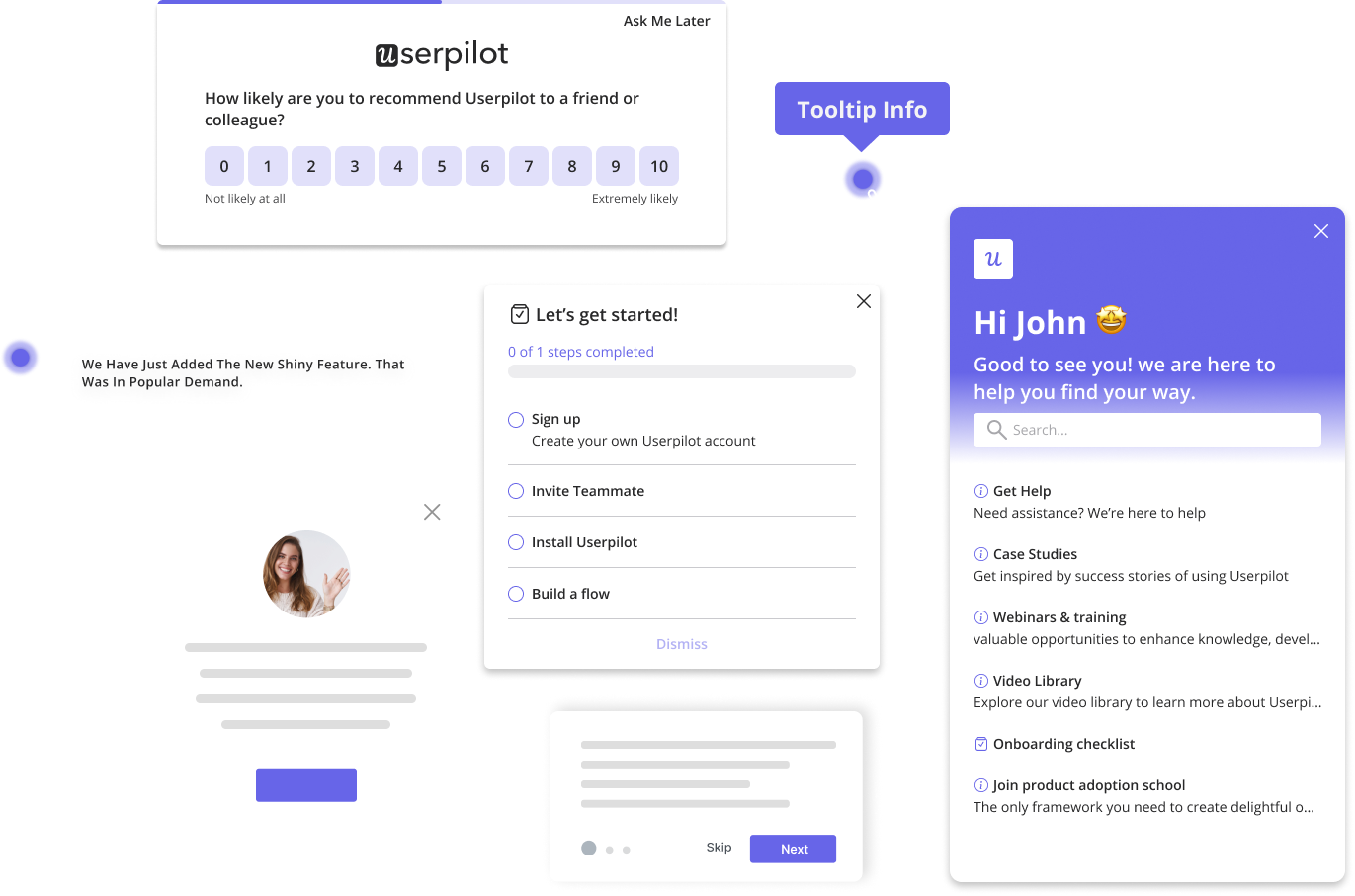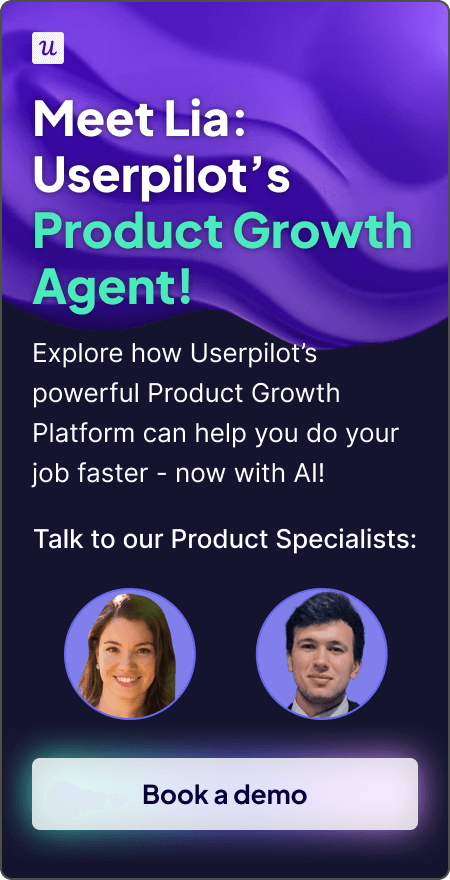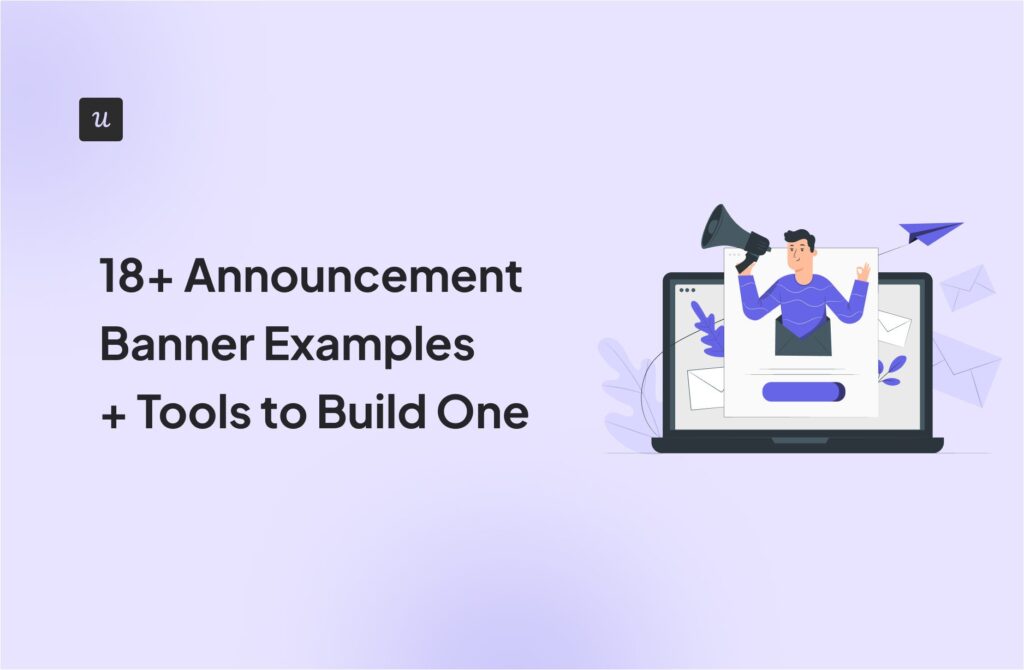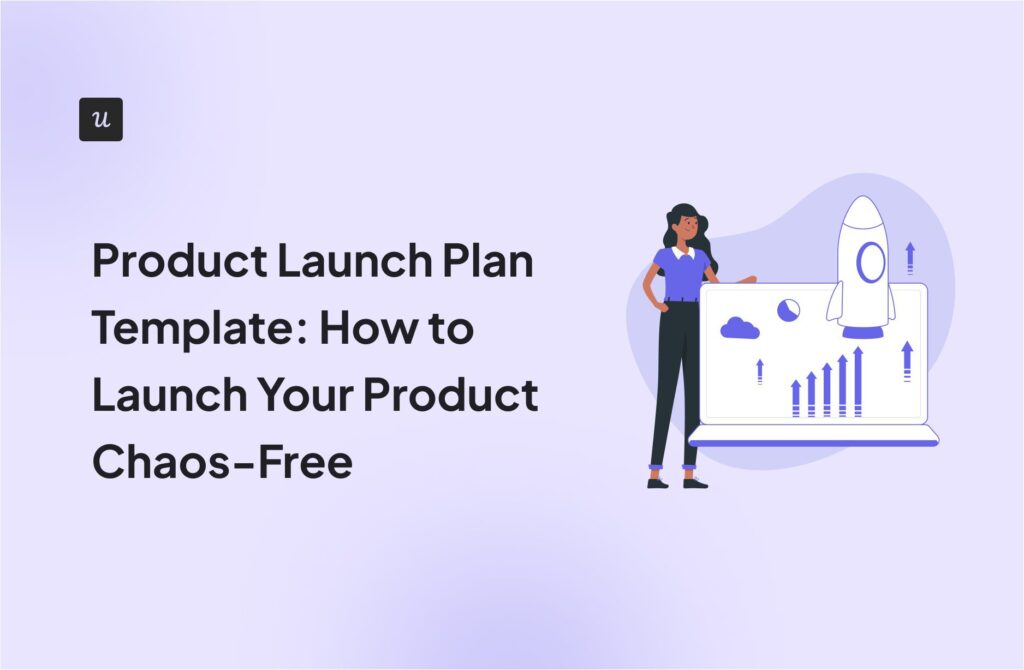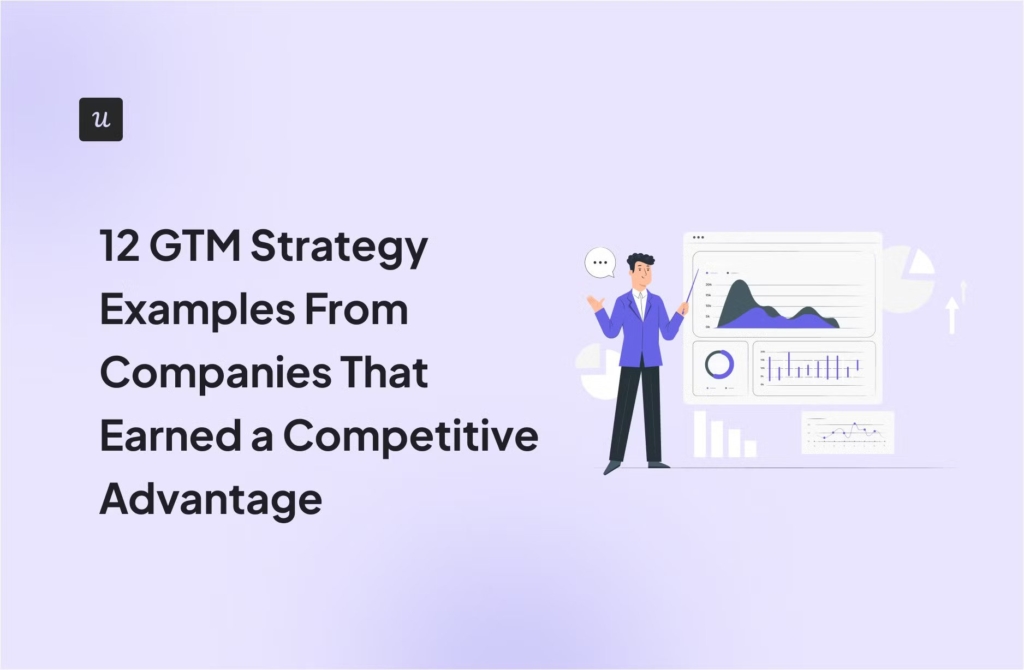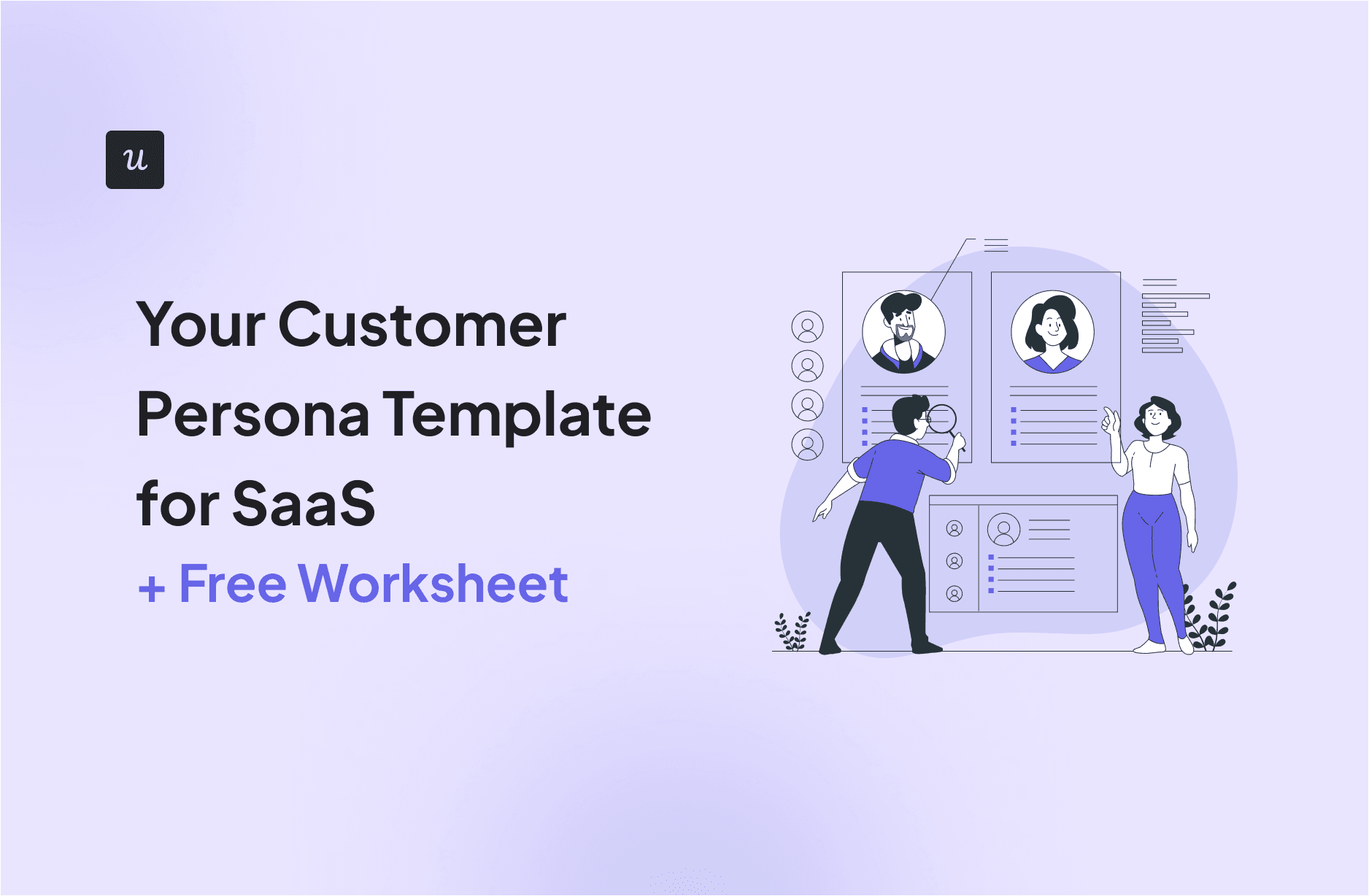
A customer persona and a customer persona template work together. Let me explain.
A customer persona, also called a buyer persona or a user persona, is a semi-fictional profile of your ideal customer. And you build it from hard data (i.e., audience data from analytics, surveys, and CRMs) and soft insights (i.e., market research from interviews, support notes, industry insights).
The goal is to humanize your target audience so your management team can design better products or services, user experiences, and messaging.
For example:
- Hard data: SaaS companies retain only 46.9% of customers after month one.
- Soft insight: Support team says “new users feel setup takes too long.”
- Direction for product team: Our persona values fast onboarding more than advanced features. In this case, an onboarding walkthrough matters more than an analytics dashboard.
But with so many insights to cover, you need a structure. That’s where the customer persona template comes in.
How are you currently building your customer personas?
What’s your biggest challenge with user personas?
What’s your main goal with a better customer persona template?
Stop Guessing, Start Growing.
It’s time to move beyond static documents. A live persona model helps you align teams, validate assumptions, and guide users to value. See how Userpilot makes your personas actionable within your product.
Try Userpilot Now
See Why 1,000+ Teams Choose Userpilot
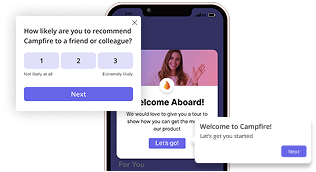
What does a customer persona template mean?
Also known as a user persona template or buyer persona template, this is the blueprint for building the profiles. It guides your team, element by element, making sure no critical insight is left out for the decision-making processes, whether that’s deciding which features to prioritize, how to position your messaging, or where to focus sales and support resources.
💡 If the persona is the character, the template is the script.
What is an example of a customer persona?
This Userpilot persona is a good model: a product manager at a B2B SaaS with 11–50 employees.
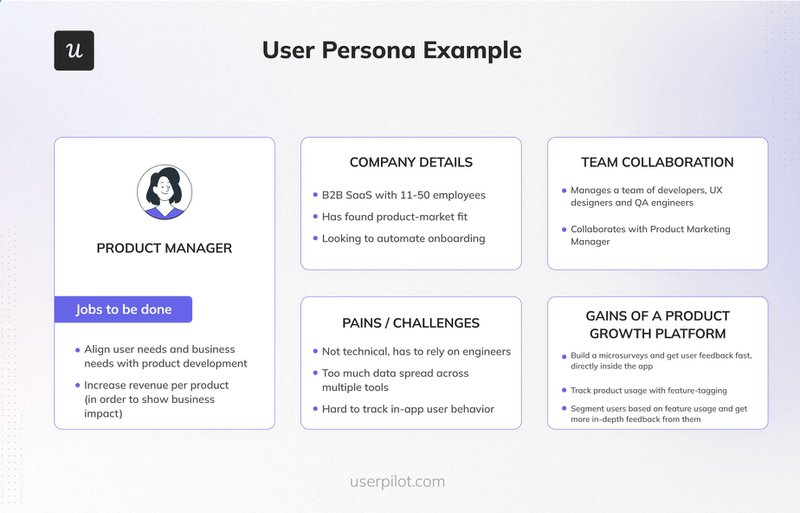
Using the example as a guide, your customer persona should at least answer these three crucial questions:
- Who is the ideal user? Who do they work with? A product manager in a B2B SaaS (11–50 employees) who manages developers, UX designers, and QA engineers, while collaborating with a product marketing manager.
- What jobs are they trying to get done (JBTD)? Align user and business needs with product development and increase revenue per product to demonstrate business impact.
- What are their main pain points or challenges? Not technical and reliant on engineers, data scattered across multiple tools, and difficulty tracking in-app user behavior.
Why bother making a customer persona template?
Three reasons: sharper targeting, fewer missteps, and measurable growth in reach and revenue.
Let’s break it down.
- Aligns teams around a “source of truth”: Personas consolidate customer insights into a single framework. This way, product, UX, marketing, and customer success all share the same picture of the user. This alignment keeps targeting sharp: every team speaks to the same needs and pain points.
- Makes you prove assumptions with data: A persona is built from analytics, surveys, customer interviews, and team feedback. That process forces you to validate ideas before acting. The result? Fewer costly missteps and a higher chance of launching features or campaigns that stick. And as Cledara’s success story shows, validating engagement assumptions with in-app cohort tests boosts adoption.
- Creates consistency across teams: With one persona template guiding decisions, tone, feature priorities, and design stay coherent, from marketing campaigns to product releases. This consistency often drives results: at Kommunicate, shared user insights guided onboarding flows and adoption nudges, resulting in an 86% feature completion rate and a 2%–3% revenue lift.
What happens when you bother:
The49, a marketing automation SaaS, adopted a persona-driven marketing strategy, and within six months, they scaled their business. This is the snapshot of the result:
| Business metric | Result | Indication |
|---|---|---|
| Customer satisfaction | +25% | Happier, retained users |
| Funding round success | +30% | Boosted investor confidence |
| Customer retention | +15% | Reduced churn, more loyal users |
| Customer acquisition cost | -20% | Leaner, more efficient growth |
Source: M Accelerator
Your free customer persona template [+ prompts]
It’s not only free, it’s also ready-to-use. Just fill the spaces using your existing customer data, insights, and market research. The placeholder prompts will guide you.
What are the key elements of a customer persona?
| Section | Prompt to fill | Ask yourself… |
|---|---|---|
| Name and role | Who is this persona? (Name + job title) | Would sales, product, or CS instantly recognize this name? |
| Basic demographics | Company size, industry, geography (and sometimes age range) | Is this a real slice of your user base, not a vague category? |
| Primary goals | What outcomes do they want? | Does this tie directly to your product’s value? |
| Pain points | What frustrates them most? | Can you prove this with data or feedback? |
| Behavioral traits | How do they work, decide, or buy? | Is this based on observed behavior? |
| Triggers | What makes them seek solutions now? | Are you clear on the events that drive urgency? |
| Objections | Why might they hesitate? | Do you know how to counter these effectively? |
| Preferred communication channels | Where do they prefer to engage? | Are you reaching them in their natural spaces? |
| Success metrics | How do they measure success? | Does this match how you show product value? |
This customer persona template gives every team the same reference point: Marketing crafts messages that resonate; Product prioritizes features that matter; and CS guides users toward their goals.
What are the 7 steps to create a persona?
While terminology varies (personas, buyer personas, user profiles), these seven broad steps work for teams (from my experience) that want practical, actionable personas:
TL; DR:
| Steps | Highlight |
|---|---|
| Ground personas in reality | Base personas on relatable data, not assumptions. |
| Capture firmographics | Include company size, industry, and geography. |
| Make them interactive | Use visuals or scenarios to bring personas to life. |
| Use customer feedback | Pull insights from tickets, churn notes, and sales objections. |
| Identify urgency | Ask “why now?” to uncover motivation triggers. |
| Ask onboarding preferences | Capture whether users want guided or self-serve onboarding. |
| Define success in user terms | Reflect how users measure value and outcomes. |
1. Ground user personas in reality
A persona only works if it mirrors real people your sales or CS team actually talks to. That means using job titles, industries, and company sizes you see in the CRM—not generic placeholders like “Decision Maker.”
A good check: Could your CS team instantly picture this user when they read the persona?
Userpilot makes this practical. You can segment users by custom attributes using “job_title = Product Manager.” This way, each persona maps directly to a live segment, making messaging and onboarding flow relevant.
And very soon, with the upcoming Product Growth Agent, you won’t need to manually crunch interview notes or survey data.
- Just describe your target persona, e.g., “mid-market product manager launching a new feature”.
- The Agent will build role-specific onboarding flows in seconds.
This shifts persona building from static documentation to living, automated journeys.
2. Tailor by company size and industry
Your customers don’t all face the same challenges. For example:
- A logistics enterprise in North America will expect different workflows than a SaaS startup in Europe.
- An SMB might need quick-start guides and lightweight onboarding, while an enterprise client prioritizes compliance, security, and detailed reporting.
Either way, the goal is tailoring. This means adjusting how you support users based on the realities of their context, i.e., size, industry, and region.
Userpilot makes that possible. With it, you can create company-level segments factoring in size, industry, and geography.
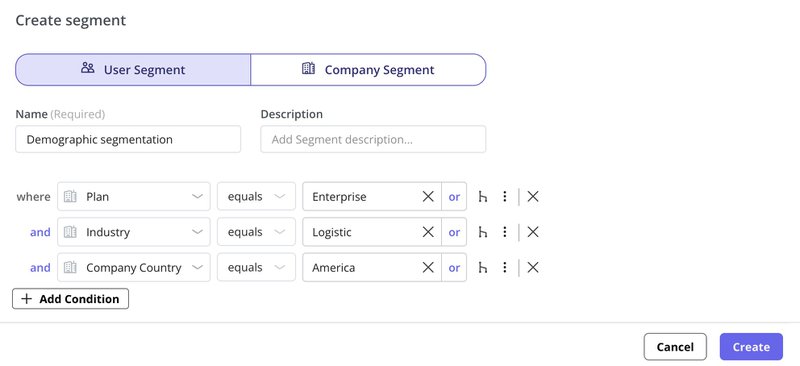
For instance, you can combine attributes like “Plan = Enterprise,” “Industry = Logistics,” and “Region = America.” This helps your target users (enterprise logistics in America) get a tailored experience.
3. Ask users about their goals
The easiest way to avoid guesswork is to ask users directly. A short in-app survey during onboarding gives you immediate insight into what they want to achieve.
For example, a customer might prioritize driving adoption of a new feature, while another cares more about reducing churn. Capturing these answers upfront helps your team.
- CS teams prioritize success playbooks.
- Product teams design products that fit real, specific needs, not assumptions.
Here’s how we structure our own onboarding flow to deliver personalized, relevant experiences from the get-go:
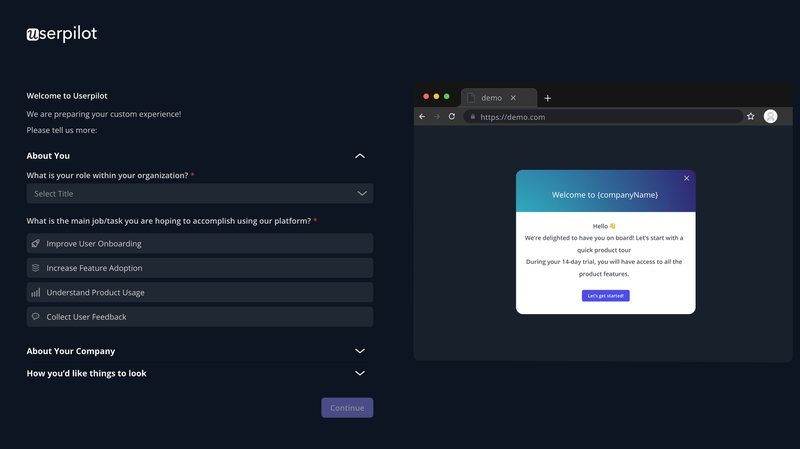
And soon, the Product Growth Agent will take it further. You will be able to auto-generate survey questions, set targeting rules, and cluster responses into persona-driven insights.
4. Pull from support tickets, churn notes, or sales objections
Your customers often tell you what’s wrong, just not always directly. The full picture lies in recurring pain points in your support tickets, churn notes, and sales objections.
For example, if multiple users complain about struggling to set up their first project, that’s a clear friction point to address in both product and onboarding.
And with Userpilot, you don’t need to wait until frustration builds. Using contextual nudges, like tooltips, modals, and banners, you can guide users at the exact moment they’re stuck.
Imagine a modal prompting someone who hasn’t set up their first project yet: “Unlock your custom dashboard by creating your first project now.” All code-free.
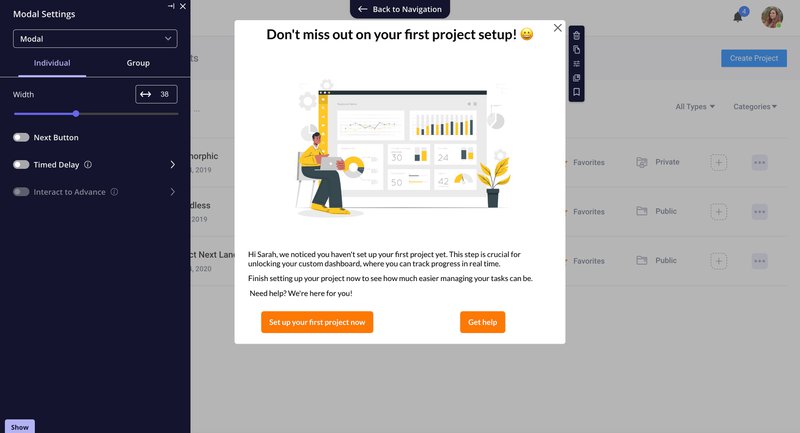
You can pair that with session replays to see the full activity log of the user click-by-click, so you know exactly where they hesitate.
Soon, Product Growth Agent will automatically analyze replays, summarize where personas struggle most, and surface the biggest friction points.
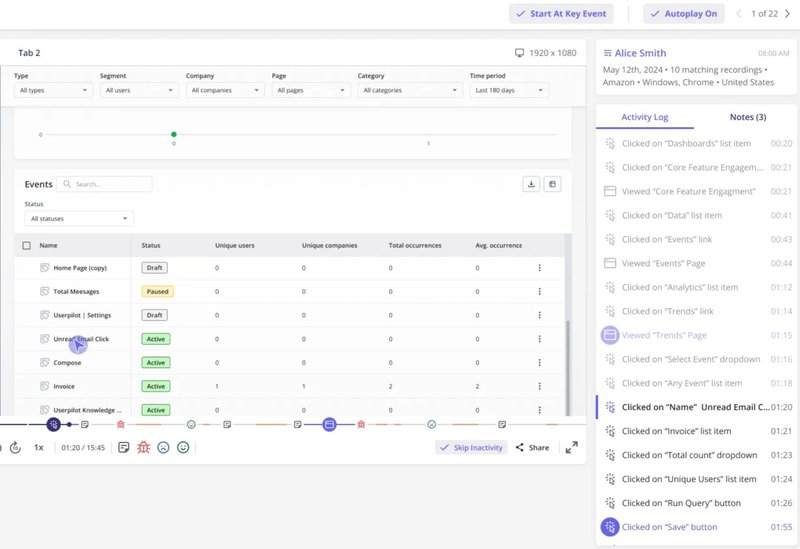
5. Identify the “why now?” trigger
Every customer has a moment when intent spikes, a “why now?” trigger that nudges them to act. To identify these, do these:
- First, look for behavioral patterns that consistently precede an upgrade or adoption.
- Then, analyze product analytics, support tickets, and sales notes to confirm recurring signals.
For example, you might find that users often expand plans immediately after completing an onboarding checklist, or that churn risk rises when usage drops after a new integration. Recognizing these moments is the first step to timing your interventions.
With Userpilot, you can turn these insights into action. Set up trigger-based flows that launch when specific conditions are met, like a checklist completion or demo view.
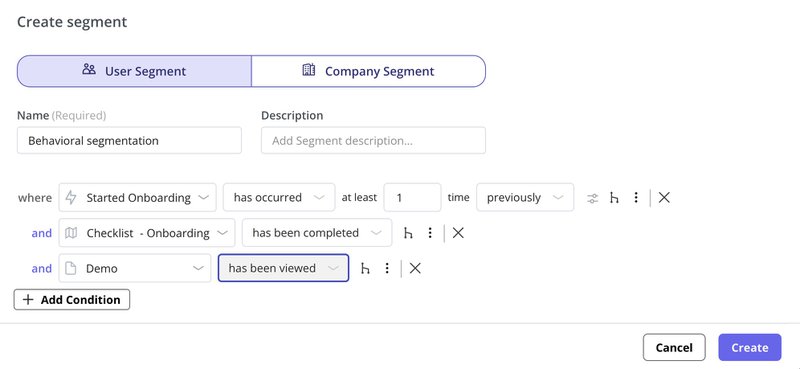
Detecting anomalies and correlations, Product Growth Agent will further uncover hidden behavior patterns, like sequences that predict churn or indicate upgrade opportunities, and suggest the best next steps (soon).
6. Match onboarding to user preference
Look at these two examples:
- A product manager who gets a guided tour to explore analytics dashboards in detail.
- A CS lead who gets a self-serve knowledge base to set up projects at their own pace.
Different users, but personalized onboarding. This way, both users stay engaged, skip distractions, and focus on tasks that drive their “Aha!” moment.
Userpilot makes the process seamless via segmentation. You can design branching onboarding flows that adapt to survey responses or in-app selections. For instance, if a user chooses “I’m here to analyze usage data,” Userpilot can automatically serve a guided walkthrough of reporting features. If another selects “I want to set up my first project,” they’ll get a checklist and self-serve resources instead.
Very soon, behavioral signals (e.g., where a user clicks first or which features they return to) and routing users into the onboarding style proven to activate them fastest will all be automated with the Product Growth Agent.
7. Define success the way your users do
For a product manager, success might be “creating the first report.” For a CS lead, it could be “onboarding three teammates.”
Identify what matters to your users, and use it to define your success metrics. This way, your product will deliver the exact value they seek.
In Userpilot, you can track success events and visualize them in dashboards. You can even trigger celebratory nudges (like a modal) when users hit milestones, e.g., create email sequences.
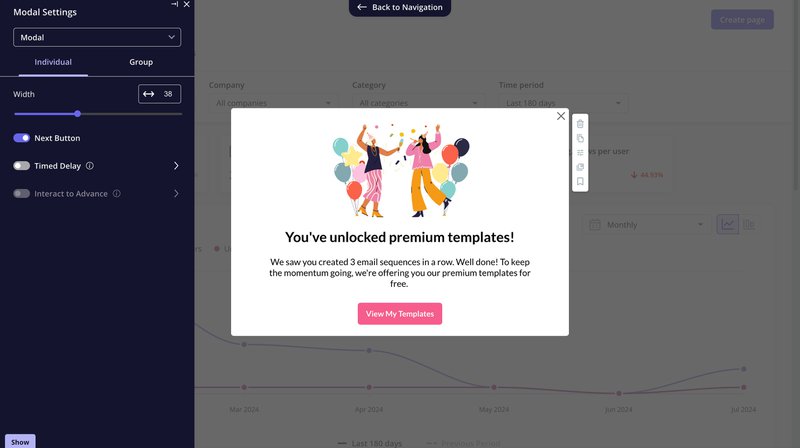
Coming soon: Product Growth Agent will flag when a persona’s KPIs are lagging, spotting anomalies and breakdowns in the dashboard. Then, you can adjust flows early before engagement drops.
The next step: Make your personas live in your product
Creating personas is just the start. Real business impact comes when they guide in-product experiences.
Imagine: new SMB users see a quick-start checklist, while enterprise admins get a compliance walkthrough. Or a marketer gets nudged toward reporting features, while a product manager explores integrations.
That’s personas in action, not just on paper. And Userpilot makes it possible.
Using Userpilot, you can segment by role, company size, or goals and deliver tailored onboarding, nudges, and success milestones code-free. Instead of static documents, your personas guide your product team.
Book your free Userpilot demo today to make your product development persona-driven.
FAQ
Which tool is used to build customer personas?
There isn’t one “right” tool; it depends on your workflow.
- Many teams start with Google Docs or Sheets because they’re easy to update and share.
- Visual learners often prefer Canva, which offers ready-made persona templates you can customize with your own data.
- If you want to centralize insights, tools like Miro or Notion make it easy to embed research, notes, and design assets in one place.
The key is not the tool itself but a persona that is simple to use daily and detailed enough to guide decisions across marketing, product, and customer success.
How to use ChatGPT to create personas?
You can use ChatGPT to speed up the process of drafting personas—just remember, AI works best when fed real data.
- Start by plugging in customer insights (from surveys, interviews, or analytics) and ask ChatGPT to organize them into a persona.
- To stay consistent, use the table in “Your free customer persona template [+ prompts].” For example, provide details like job role, goals, and pain points, and ChatGPT will help you phrase them clearly.
ChatGPT won’t replace your research, but acts as a smart assistant for summarizing findings and turning raw input into a usable, shareable profile.
How detailed should a persona be?
A good persona should capture demographics, goals (interests and hopes), pain points, behaviors, and success metrics. This will suffice for marketing to craft consistent messaging, product to prioritize features, and CS to guide users.
Here’s a quick test you can try: Can your persona drive a real product or messaging decision tomorrow? If you answer yes, it’s detailed enough for your ideal customer. Anything beyond that is unnecessary.

